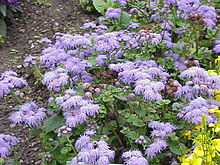Eupatorieae
| Eupatorieae | |
|---|---|
 |
|
| Ageratum houstonianum | |
| Scientific classification | |
| Kingdom: | Plantae |
| (unranked): | Angiosperms |
| (unranked): | Eudicots |
| (unranked): | Asterids |
| Order: | Asterales |
| Family: | Asteraceae |
| Subfamily: | Asteroideae |
| Supertribe: | Helianthodae |
| Tribe: |
Eupatorieae Cass. 1819 |
| Genera | |
|
About 170–184; see text for a complete list. |
|
About 170–184; see text for a complete list.
Eupatorieae is a tribe of over 2000 species of plants in the aster family. Most of the species are native to tropical, subtropical, and warm temperate areas of the Americas, but some are found elsewhere. Well-known members are Stevia rebaudiana (used as a sugar substitute), a number of medicinal plants (Eupatorium), and a variety of late summer to autumn blooming garden flowers, including Ageratum (flossflower) and Conoclinium (mistflower).
Plants in this tribe have only disc florets (no ray florets) and petals which are white, slightly yellowish off-white, pink, or purple (never a full yellow).
Within the aster family, the Eupatorieae are in the subfamily Asteroideae. Within Asteroideae, they are in the supertribe Helianthodae. Within Helianthodae, they belong to an informal group without taxonomic rank called the phytomelanin cypsela clade, which contains 11 tribes.
The sister tribe of Eupatorieae is probably Perityleae. This result received moderate statistical support (68% bootstrap percentage) in a study published in 2002.
The following list of 185 genera is modified from Hind and Robinson (2007) by the addition of Eutrochium, Paneroa, and Zyzyura.
The largest genera and the approximate number of species in each are: Mikania (440), Ageratina (290), Stevia (200), Chromolaena (165), Koanophyllon (120), Brickellia (100), and Fleischmannia (95).
Sources:
In 1987, Robert M. King and Harold E. Robinson wrote a book on Eupatorieae. In this book, they divided the tribe into 18 subtribes. These are Hofmeisteriinae, Oxylobinae, Oaxacaniinae, Mikaniinae, Trichocoroninae, Adenostemmatinae, Fleischmanniinae, Ageratinae, Eupatoriinae, Liatrinae, Praxelinae, Gyptidinae, Disynaphiinae, Ayapaninae, Alomiinae, Critoniinae, Hebecliniinae, and Neomirandeinae.
...
Wikipedia
